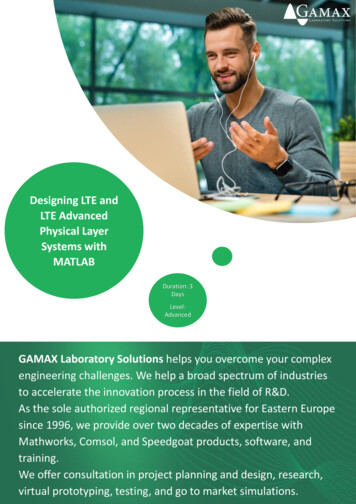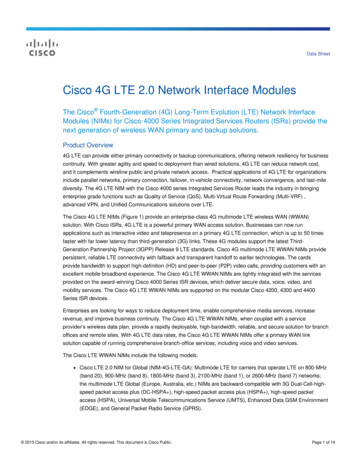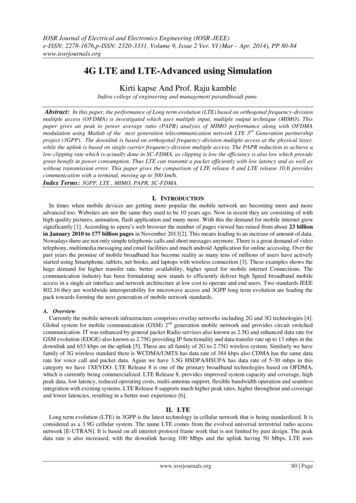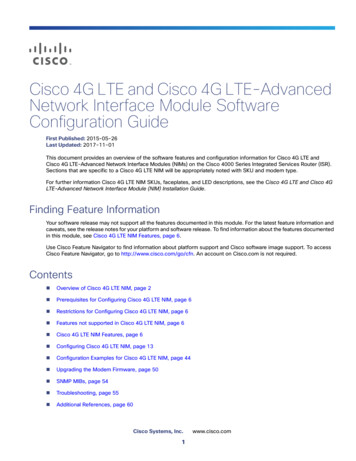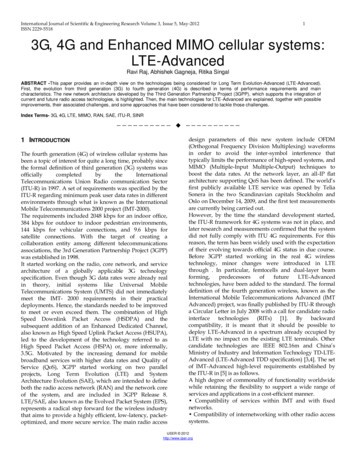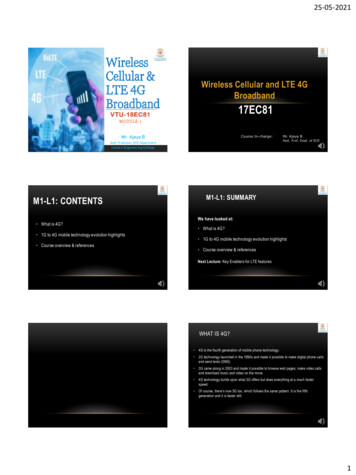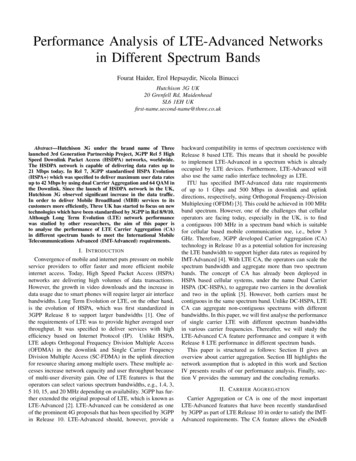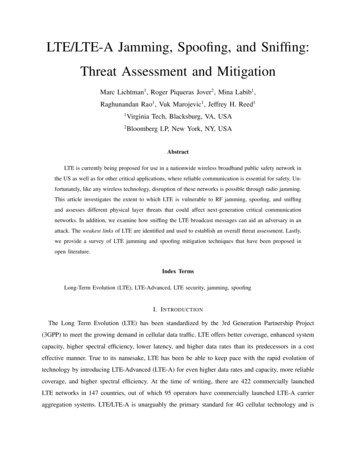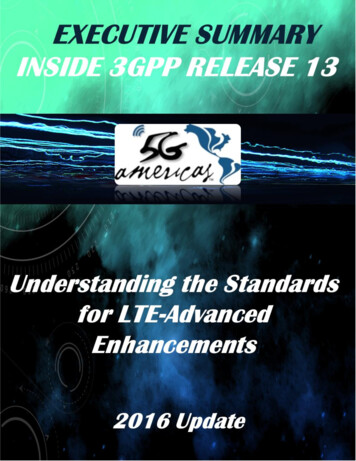
Transcription
FOREWORDFor nearly 15 years, 5G Americas (and 3G Americas and 4G Americas) has published white papers thatcondense and explain the standards work by 3GPP on the GSM-UMTS-LTE family of technologies. InJune 2015, a working group of member company experts prepared a detailed report, Mobile BroadbandEvolution Towards 5G: 3GPP Release 12 & Release 13 and Beyond to help in understanding the futureof wireless broadband and how new requirements and technological goals will be achieved. An ExecutiveSummary – Inside 3GPP Release 13: Understanding the Standards for HSPA and LTE-AdvancedEnhancements was published in August 2015. With the completion of Release 13 standards in March2016, the Executive Summary on Release 13 is being updated to reflect any changes since June 2015 inthis current publication.INTRODUCTIONEXECUTIVE SUMMARYInside 3GPP Release 13: Understanding the Standards for LTE-Advanced Enhancements2016 UpdateThere are more than 7.2 billion wireless connections 1 using the 3rd Generation Partnership Project (3GPP)standards, including 1.45 billion LTE connections, and increasingly those connections are interoperatingwith other wireless technologies including Wi-Fi. 3GPP Release 13 (Rel-13) will further advance LTE towardthe wireless broadband foundation for the fifth generation (5G) or IMT-2020. 5G mobile technology willneed to face unprecedented challenges: accommodating skyrocketing traffic growth amid a spectrumshortage, escalation of the Internet of Things (IoT) and a vision for network transformation that will createan all-IP environment. All of that will not be alleviated until the next decade or further as IMT-2020 or 5Gtechnology begins to take shape.However, the 3GPP standards have many innovations remaining for both LTE and HSPA to create afoundation for 5G. Rel-12, which was finalized in December 2014, contains a vast array of features for bothLTE and HSPA that brings greater efficiency for networks and devices, as well as enables newer services.As in previous releases, and given the large number of features first introduced in Rel-12, many wereextended into Rel-13. Rel-13 continues to build on these while adding many rich new features of its own.Rel-13 was functionally frozen in December 2015, and completed in March 2016 (with an exception tocomplete the NB-IoT feature by June 2016).In this executive summary, a concise overview of the main Rel-13 features is provided. More detailedexplanations of 3GPP Rel-13 are provided in the 4G Americas white paper, Mobile Broadband EvolutionTowards 5G: Rel-12 & Rel-13 and Beyond and will be further explained in a future paper on Releases 13to 15 toward the later part of 2016.For LTE-Advanced, Rel-13 supports Active Antenna Systems (AAS), including beamforming, Multi-InputMulti-Output (MIMO) and Self-Organizing Network (SON) aspects, enhanced signaling to support inter-siteCoordinated Multi-Point Transmission and Reception (CoMP), Carrier Aggregation (CA) enhancements tosupport up to 32 component carriers and Dual Connectivity (DC) enhancements to better support multivendor deployments with improved traffic steering. Improvements in Radio Access Network (RAN) sharing1 Ovum, WCIS . June 2016. [Data does not include M2M]1
have also being worked on as part of Rel-13. Work on enhancements to Machine Type Communication(MTC) and Proximity Services (ProSe) continued from Rel-12.Further features addressed in Rel-13 are: Licensed Assisted Access for LTE (LAA), in which LTE can bedeployed in unlicensed spectrum, LTE Wireless Local Area Network (WLAN) Aggregation (LWA) whereWi-Fi can now be supported by a radio bearer and aggregated with an LTE radio bearer, Narrowband IoT(NB-IoT) where lower power wider coverage LTE carriers have been designed to support IoT applications,and Downlink (DL) Multi-User Superposition Transmission (MUST) which is a new concept for transmittingmore than one data layer to multiple users without time, frequency or spatial separation.For HSPA , the main Rel-13 items are enhancements for reducing control channel overhead and supportfor dual band Uplink (UL) Carrier Aggregation.With respect to network-related services, Rel-13 introduces Wi-Fi integration enhancements to supportNetwork-Based IP Flow Mobility (NBIFOM) enhancements to harmonize the support of voice and videoservices over Wi-Fi and enhancements to support Mission Critical Push-to-Talk (MCPTT) over LTE forpublic safety. Rel-13 continues work from Rel-12 in optimizing performance for MTC services by defininga Dedicated Core (DECOR) and Monitoring Enhancement (MONTE) for MTC services, as well asenhancements to MBMS, ProSe and group communications.Additional features in network-related services include the User Plane Congestion Management (UPCON)feature which enables the identification of cells and users in congested situations so that policy decisionscan be used to mitigate congestion, and the Application Specific Congestion Control for DataCommunication (ACDC) can manage access attempts on a per application basis. ArchitectureEnhancements for Service Capability Exposure (AESE) was added in Rel-13 to expose valuableinformation to third party application providers.As 3GPP Rel-13 was being completed to further develop the standards for HSPA and LTE/LTE-Advanced,simultaneous discussion on future network requirements and recommendations for the next generation of5G technologies was also underway. Groups such as 5G Americas are contributing to the discussion andare liaising with other organizations such as NGMN Alliance, 5G PPP, ATIS, ITU, Small Cell Forum andothers. 5G Americas has published several white papers on 5G topics including spectrum and technologyrecommendations. Discussions in the 3GPP working groups have turned to 5G standardization in Rel-14and Rel-15.The summary following is an overview of some of the key features in Rel-13.2
3GPP RELEASE 13: HSPA AND LTE-ADVANCED1. E-UTRAN/LTE-ADVANCED ENHANCEMENTS1.1 ACTIVE ANTENNA SYSTEMS (AAS)Active Antenna Systems (AAS) introduces advanced antenna systems, usually comprised of radiatingelements and transceiver units, to Base Stations (BS) installations as shown in Figure 1. In TR 37.8423GPP2 defines an active antenna system base station as a base station which combines an antenna arraywith a transceiver unit array, and optionally a radio distribution network covering single- and multi- radioaccess technologies and coverage scenarios from local- to wide-area.Rel-13 identified the RF requirements that may be needed for an AAS BS specification and the necessaryconformance testing derived from those RF requirements.Transceiver Array Boundary (TAB)#1Transceiver Unit #1RadioDistributionNetwork(RDN)TXU/RXU #2TXU/RXU #NTRXUTransceiver Unit Array(TRXUA)AntennaArray(AA)#NTABCTAB connectorFigure 1. General Active Antenna System Base Station Architecture.1.2 SELF-OPTIMIZING NETW ORKS (SON) FOR ACTIVE ANTENNA SYSTEM(AAS) DEPLOYMENTSActive Antenna Systems (AAS) allow the creation of multiple vertical and horizontal (or combination) beamsmaking the cell deployment dynamic. This enables dynamic cell splitting/merging to handle changing loadconditions in the cell. Rel-13 focused on ensuring the connection continuity and adapting the existingSON/MRO principles (from earlier releases) during the dynamic deployment changes due to AAS-based23GPP TR 37.842 V1.12.0 (2016-08) Radio Frequency (RF) requirement background for Active Antenna System(AAS) Base Station (BS) (Release 13).3
deployments without impacting the RRM mechanism. This was achieved by synchronous handling betweenOAM based configuration and X2 signaling.1.3 ELEVATION BEAMFORMING (EBF) AND FULL DIMENSION (FD) MULTIINPUT MULTI-OUTPUT (MIMO)After extensive study of EBF-FD MIMO 3 [, 3GPP has concluded and decided to support severalenhancement techniques in Rel-13 including non-precoded CSI-RS transmission schemes, beamformedCSI-RS transmission schemes, SRS enhancement for TDD, DMRS enhancement for higher order multiusertransmission and CSI measurement restriction.For non-precoded CSI-RS transmission schemes based on Class A CSI reporting, a number of newcodebooks have been designed for 1D and 2D antenna arrays based on CSI measurement over nonprecoded CSI-RS ports. Another category of CSI measurement and feedback supported in Rel-13 is basedon beamformed CSI-RS transmission with Class B CSI reporting. In general, Class B CSI reporting can becategorized as techniques of CSI dimensionality reduction compared to Class A CSI reporting. SRStransmission is further enhanced in Rel-13 because of the implementation of AAS and channel reciprocitybased MIMO operation. From downlink perspective, DMRS ports 7, 8 and 11 and 13 with OCC4 can beused for multiuse transmission because of increased likelihood of high order MU pairing. Therefore with thecombination of four orthogonal DMRS ports using OCC and two non-orthogonal DMRS ports usingscrambling identities, up to 8 multi-user layers can be supported from Rel-13. Last but not least, Rel-13 cansupport CSI measurement restriction, with either channel measurement restriction, or interferencemeasurement restriction, or both. With channel measurement restriction, the mechanism of beam probingcan be supported at the time domain UE-transparently.1.4 ENHANCED SIGNALING FOR INTER-ENB COORDINATED MULTI-POINT(CoMP)The goal of this work item is to introduce a coordination mechanism to reduce interference between twoeNBs. It is believed that Inter-eNB CoMP can provide better performance by improving the coverage ofhigh data rates, cell-edge throughput and overall system throughput coordinated scheduling. Such acentralized (master/slave) approach, where slave eNBs operating in a cluster provide coordinationinformation to a Centralized Coordination Function (CCF), is shown in Figure 2.Figure 2. Centralized Approach with CCF.3TR 36.897 Study on Elevation Beamforming/Full-Dimension (FD) MIMO for LTE.4
Figure 3 summarizes the enhancements to inter-eNB CoMP as part of Rel-13.Figure 3. Enhancements to Inter-eNB CoMP as part of Rel-13.1.5 FURTHER LTE PHYSICAL LAYER ENHANCEMENTS FOR MACHINETYPE COMMUNICATION (MTC)The general aim is to specify a new UE for MTC operation in LTE that also allows for enhanced coveragecompared to existing LTE networks and low power consumption. The main target areas are as follows.Introduction of a new Rel-13 low complexity UE category/type for MTC operation: to be applied in any LTEduplex mode (full duplex FDD, half duplex FDD, TDD), based on the Rel-12 low complexity UEcategory/type supporting the following additional capabilities: Reduced UE bandwidth of 1.4 MHz in downlink and uplinkReduced maximum transmit powerReduced support for downlink transmission modesFurther UE processing relaxations can also be considered1.6 INDOOR POSITIONING ENHANCEMENTSThe Indoor Positioning Study Item was initiated in September of 2014 to analyse potential enhancementsthat would improve positioning both indoors and in other challenging environments. This was driven by theobservation that mobile devices are used increasingly indoors. In the U.S., the FCC in January of 2015issued the Fourth Report and Order on Wireless E911 Location Accuracy Requirements 4 . This order4FCC Fourth Report and Order in the Matter of Wireless E911 Location Accuracy Requirements, PS Docket No. 07114.5
requires that wireless providers provide either a dispatchable location or an x/y location within 50 metersfor 80 percent of all wireless 911 calls within six years. Within eight years, wireless providers must deploydispatchable location or z-axis technology that meets yet undetermined z-axis accuracy metric. Further,there are several interim benchmarks that must be met before the final six and eight year requirements.The current Study focuses on methods that provide x/y/z-axis and not dispatchable location.After the indoor positioning study item was completed [TR 37.857], 3GPP initiated a Rel-13 indoorpositioning work item. This work item, completed in December 2015, resulted in the introduction of thefollowing new positioning methods targeted to address the indoor positioning needs [TS 36.305 v13.0.0]: Barometric sensor methodWLAN methodBluetooth methodTerrestrial Beacon System method1.7 LICENSED ASSISTED ACCESS (LAA) USING LTELicensed-assisted access (LAA) is a 3GPP enhancement of Long-Term Evolution (LTE) in the unlicensedspectrum, which has been standardized in LTE Release 13. Under LAA, licensed carriers are aggregatedwith unlicensed carriers in order to opportunistically enhance downlink user throughput while still offeringseamless mobility support. In order to coexist with Wi-Fi in the unlicensed spectrum, enhancements includea mechanism for channel sensing based on listen-before-talk (LBT), discontinuous transmission on a carrierwith limited maximum transmission duration, dynamic frequency selection (DFS) for radar avoidance incertain bands, and multicarrier transmission across multiple unlicensed channels. The DTX and LBTfunctionalities will have a major impact on various aspects of LTE ranging from downlink physical channeldesign, channel state information (CSI) estimation and reporting, hybrid ARQ (HARQ) operation, to radioresource management (RRM) as shown in Figure 4.Figure 4. LAA DL Transmissions with LBT CW Updates Based on HARQ ACK/NACK Feedback.6
1.8 CARRIER AGGREGATION (CA) ENHANCEMENTSCarrier aggregation was first introduced in Rel-10, allowing operators to use their spectrum assets moreefficiently, to boost user throughputs, and increase capacity. Through Rel-12, aggregation of up to fivecarriers and bandwidths up to 100MHz are supported.In Rel-13, the carrier aggregation framework was extended to support up to 32 carriers, targeting carriersin unlicensed spectrum to be used in conjunction with LAA. With Rel-13 CA enhancements, in principle,LTE terminals will be able to handle bandwidths up to 640 MHz, most of which will be located in unlicensedspectrum, hence allowing UEs to achieve tremendous data rates.1.9 DOWNLINK MULTI-USER SUPERPOSITION TRANSMISSION (MUST)A new Study Item was initiated in March 20155 to investigate the benefits of downlink Multi-user SuppositionTransmissions (MUST), a concept of joint optimization of multi-user operation from both the transmitter andreceiver’s perspective. The objective of this study is to investigate the potential gain of schemes enablingsimultaneous transmissions of more than one layer of data for more than one UE within one cell withouttime, frequency and spatial layer separation. This concept may have a potential to further improve multiuser system capacity while orthogonal beams and layers from a cell are limited, so that more than one layerof data transmission in a beam using superposition coding becomes beneficial. The details of superpositioncoding are for further study, but an advanced receiver with successive interference cancellation capabilityis commonly assumed.1.10 RADIO ACCESS NETWORK (RAN) ASPECTS OF RAN SHARINGENHANCEMENTSRAN Sharing allows multiple participating operators to share the resources of a single RAN according toagreed allocation schemes. The Shared RAN is provided by a Hosting RAN Operator (a provider of aHosting RAN) which can be one of the participating operators (operator that uses allocated shared RANresources provided by a Hosting RAN Provider under agreement). With the growing deployment of theshared network, operators anticipate the scenarios where CN and/or RAN overload can result in a situationwhere an overloaded PLMN’s users can starve another PLMN’s users, thus leading to unfairness.Current mechanisms of EUTRAN sharing do not allow a hosting provider to calculate and enforce policingof DL and UL data volumes used by a participating operator (per PLMN). Hence, new functions were addedin Rel-13 to enable aggregated DL and UL data volume collection per PLMN and per QoS profileparameters. Depending on Sharing Operators agreement, a QoS profile may be limited to a subset ofstandard parameters (e.g., QCI).1.11 ENHANCED LTE DEVICE-TO-DEVICE (D2D) PROXIMITY SERVICES(ProSe)The Rel-13 work on D2D ProSe covers enhancements to LTE device-to-device communications anddiscovery, meeting public safety requirements for in-network coverage (intra-cell and inter-cell), partialnetwork coverage and outside network coverage scenarios. For non-public safety discovery, the work item5 RP-150496: Downlink Multiuser Superposition Transmission for LTE.7
covers in-network coverage (intra-cell and inter-cell) only. In particular, the work will cover enhancementsto D2D discovery, enhancements to D2D communication, and enhancements and specs in support ofProSe related MCPTT requirements identified by SA groups (e.g., performance of call-set-up), the study ofadditional co-existence issues with adjacent carrier frequencies that may arise due to the new mechanismsbeing defined, and the Definition (if needed) of additional Tx/Rx RF and RRM core requirements for the UE.The proposed solutions should enable D2D services on the same or on different carrier(s) than that usedfor LTE WAN communication by the UE.1.12 DUAL CONNECTIVITY ENHANCEMENTSDual Connectivity in Rel-13 builds on the capabilities provided in Rel-12, including addressing uplink bearersplit. In Rel-13 a UE reporting method to determine the time difference between PCell and PSCell has beenadded. The UE uses the SFN and Sub-Frame number of both the PCell and PSCell to calculate the timingdifference between MeNBs and SeNBs which is deemed important for multi-vendor deployments. Trafficsteering during DC operation is also supported in Rel-13. It is believed that the increase in demand forhigher data requiring more small cells deployed for coverage could increase the traffic load at the corenetwork significantly. DC can benefit from offloading certain services to minimize core network congestionand hence more flexible traffic steering techniques are necessary for DC. To offload operator network inDC scenario, local breakout is important as it provides the operator with the means for efficient backhaulusage and reduces the load on the core network. Two existing mechanisms for traffic redirection are LocalIP Access (LIPA) and Selective IP Traffic Offload (SIPTO) already defined in 3GPP. LIPA is used for HeNBonly, whereas SIPTO is used for both HeNB as well as Macro eNBs.1.13 LTE-WIRELESS LOCAL AREA NETWORK (WLAN) RADIO LEVELINTEGRATION AND INTERWORKING ENHANCEMENTSThe Rel-13 standard work on LTE-WLAN Radio Level Integration and Interworking Enhancements includesthree main components/features: LTE-WLAN Aggregation (LWA), which builds upon 3GPP Rel-12 Dual Connectivity split-bearerarchitecture with aggregation of data links at PDCP layer, and allows utilization of radio resourceson both LTE and WLAN simultaneously for a data bearerLTE-WLAN Radio Level Integration with IPsec Tunnel (LWIP) integrates 3GPP RAN with WLANnetwork above the PDCP layer using IPsec tunnelling without requiring any modifications to theWLAN network, and allows use of WLAN radio resources for LTE traffic in both uplink and downlinkRAN Controlled LTE WLAN Interworking (RCLWI), which builds upon 3GPP Rel-12 RAN AssistedWLAN Interworking by allowing eNB to send a steering command to the UE for WLAN offload, inpart based on UE measurements for WLANThe main goal of LWA is to allow offloading of data from cellular more efficiently than earlier solutions forWLAN deployments either by a mobile network operator and/or its partners. In all previous WLAN solutionsdeveloped by 3GPP, the anchor point for the traffic was Core Network and in particular S-GW and thedecision to offload is done by the UE (with some assistance information in Rel-12 solution). LWA uses eNBas the anchor point and decision making node, which allows more dynamic and granular offloadingdecisions. LWIP was introduced in Rel-13 to address the operator needs to leverage the capacity availablefrom the large incumbent WLAN network base where modifications to WLAN, as required by LWA wouldnot be feasible because of hardware, architectural or operational constraints. The use of WLAN resources8
in downlink and uplink is controlled by the eNB, and completely bypasses the LTE user plane protocolstack. LWIP allows use of combined LTE and WLAN capacity for a user by allowing either inter-bearerdistribution or intra-bearer per IP flow distribution across the LTE and WLAN radio links. RCLWI still usesCN-based offloading but the eNB can make the decision to steer traffic between LTE and WLAN which canprovide better performance compared to previous CN based solutions. 3GPP WLAN offloading solutionsalways allow the user preferences to have higher priority over standardized mechanisms offered by thenetwork. The same principle also applies to LWA and RCLWI.1.14 RADIO ACCESS NETWORK (RAN) ENHANCEMENTS FOR EXTENDEDDISCONTINUOUS RECEPTION (DRX) IN LTEAs already identified by earlier 3GPP releases, reducing significantly UE power consumption can be veryvaluable for certain UEs (e.g., for MTC/IOT sensors that run on small batteries may be a major cost toexchange/charge batteries; otherwise the battery duration may simply determine the device’s lifetime). InRel-12, 3GPP adopted a NAS layer solution-defined Power Saving Mode (PSM), allowing a very low UEpower consumption in certain use cases (e.g., Mobile Originated (MO)-only or scheduled MobileTerminated (MT) data). However, the PSM has limited applicability for unscheduled MT data with a certainrequirement on delay tolerance. If the maximum allowable delay tolerance is less than the order of manyhours, the PSM solution may not be so efficient, due to more frequent periodic registrations. Anotherapproach to provide better UE power consumption in those scenarios (partly studied in Rel-126 7), is toextend current DRX operation.In Rel-13, 3GPP standardized a RAN-based solution for extended DRX 8 to address the previouslydescribed shortcomings: Extend idle mode DRX cycles up to approximately 45 minutes (for non-NB-IoT) or 3 hours for NBIoTExtend connected mode DRX cycles up to 10 seconds1.15 RAN ASPECTS OF CELLULAR INTERNET OF THINGS (CIOT) ANDNARROWBAND INTERNET OF THINGS (NB-IOT)CIOT & NB-IOT are adopted by 3GPP in order to compete with LPWA arena for providing connectivity inthe exponentially growing market of the Internet of Things services.The requirements that lead their development are based on TR45.820, which mainly focuses on: Reduced UE complexityImproved power efficiencyImproved indoor coverageSupport of massive number of low throughput devices6TR 23.887: Study on Machine-Type Communications (MTC) and other mobile data applications communicationsenhancements.7 TR 37.869: Study on Enhancements to Machine-Type Communications (MTC) and other Mobile Data Applications;Radio Access Network (RAN) aspects.8 RP-150493: RAN enhancements for extended DRX in LTE.9
With these requirements in mind, the main design goal is not backwards compatibility, but rather enablingnew IoT technologies with minimal impact to existing 3GPP RAN nodes. CIOT focuses on GSM/GPRStechnology and NB-IOT focuses on LTE.CIOT was designed to share radio resources with existing GSM/GPRS systems, and therefore using the200 kHz channelization present in this RAT. The main characteristics of this technology are shown in Table1.Table 1. Characteristics of Cellular Internet of Things GSM/GPRS Systems.DeploymentIn-Band GSMMCL (Coverage)164 dB (33dBm power class UE)154 dB (23dBm power class UE)DownlinkTDMA/FDMA GMSK and 8PSK (optional), 1RxUplinkTDMA/FDMA GMSK and 8PSK (optional)Bandwidth200KHz channelization. Typical system requirement 1.4MHz(600kHZ under study)Peak data rate70 kbps with GMSK and 240 kbps with 8PSKDuplexHD FDD (in order to achieve reduced cost UE with a single RFchain)Power savingPSM and ext I-DRX (in order to improve power efficiency)Power class23 dBm and 33 dBmNB-IOT has been designed to be integrated in LTE eNBs, with three type of deployments envisaged forthis technology: In-band, integrated as part of the resource regularly used for the eNB communicationGuard band, using 180 kHz of the unused frequency band between the last Physical ResourceBlock (PRB) used and the channelization edgeStandalone system in any assigned band, such as a re-farmed channel from a previousGSM/GPRS system owned by the operatorThe main characteristics of NB-IOT are summarized in Table 2.Table 2. Characteristics of Narrowband Internet of Things Using LTE.DeploymentIn-Band LTE, Guard band LTE, StandaloneMCL (Coverage)164 dBDownlinkOFDMA (15 KHz subcarrier spacing), 1 Rx, 1 or 2 TX antennaUplinkSC-FDMA (15 KHz subcarrier spacing) Turbo Code or SingleTone (15kHz and 3,75 kHz spacing)10
Bandwidth180 kHz (1 PRBs) inside eNB assigned BWPeak data rate250 kbps (20 kbps for UL single tone)DuplexHD FDD, TDDPower savingPSM, ext I-DRX, C-DRXPower class23 dBm2 UTRAN/HSPA ENHANCEMENTS2.1 DOWNLINK (DL) ENHANCEMENTSThe DL enhancements for UTRAN/HSPA in Rel-13 focused on: Algorithm 3 (allows to slow down the inner loop power control by applying decimation on the TPCcommands transmitted in downlink)URA PCH with seamless transmission (by introducing unique URA-wide identities, the UE cankeep them while in URA PCH and can avoid Cell Update procedures when it has data to send)Improved Synchronization RRC Procedures (faster activation by RNC sending an indication in theRRC reconfiguration message that the UE and the Node B agree on an activation time)Retrievable Configurations (an indication is included in the RRC reconfiguration message tellingto the UE to store the values of a defined set of parameters together with an identity)Enhanced State Transition (allows UEs to transition to a pre-configured state after finalized datatransmission)2.2 SMALL DATA TRANSMISSION ENHANCEMENTSThis feature targets very long battery life (e.g. up to few years) for MTC/IoT type devices by extending theIdle mode UTRA DRX cycle. The extended Idle mode DRX (eDRX) ranges from 10.24 seconds up to 44minutes (for the PS domain). Legacy Idle DRX could go up to 5.12 seconds. In essence, the Idle eDRXbehavior is still based on Paging Occasions (PO) as determined by the CN (PS) domain-specific DRX cyclelength coefficient that is broadcast by the network. However, the UE is not required to monitor every PO,but only the POs that belong to a certain Paging Transmission Window (PTW). This is illustrated in Figure5.11
Figure 5. Extended DRX in Idle Mode.2.3 DUAL BAND UPLINK (UL) CARRIER AGGREGATION (CA)Leveraging from existing HSPA multi-carrier data aggregation features, such as Dual Band Dual Cell((DB)DC)/4C-HSDPA (DL) and DC-HSUPA (UL), this new functionality extends UL multi-carrier operationby aggregating two UL carriers across bands.An example of target dual-band deployment scenario is shown in Figure 6.Figure 6. Example of (Co-Located) Dual-Band Deployment.3. NETWORK SERVICES RELATED ENHANCEMENTS3.1 IP FLOW MOBILITY SUPPORT FOR S2A AND S2B INTERFACESPrior to Rel-13, mechanisms have been defined for simultaneous connectivity over Wi-Fi and 3GPP-basedtechnologies for different PDN connections. The NBIFOM feature standardized in Rel-13 added the IFOMfunctionality for the PMIP and GTP-based mobility protocols for both trusted (S2a based) and untrusted(S2b based) WLAN access, as shown in Figure 7.12
GatewayOperator's IPServices (e.g.IMS, PSS, etc.)S5S6bS2bGxbS2aSWm3GPP AAAServerePDGSWnHPLMNNon-3GPPNetworksTrustedWLAN AccessNetworkSWwUESWuUntrustedWLAN AccessNetworkSWaSTaUEFigure 7. Non-Roaming Architecture within EPS Using S5, S2a and S2b.93.2 USER PLANE CONGESTION MANAGEMENT (UPCON)The User-Plane Congestion (UPCON) Work Item aims at detecting and mitigating situations where theoffered load exceeds the capacity of the RAN to transfer user data for a few seconds or longer (short burstsin offered load are not in scope). 3GPP Working Group (WG) SA1 defined related requirements (see TS22.101) not only address detection of congestion (“The network shall be able to detect RAN user planecongestion onset and abatement”), but also to specify the foreseen mitigation measures. As depicted inFigure 8, a new architectural entity (RAN Congestion Awareness Function (RCAF)) has been added to3GPP specifications. The RCAF performs three key tasks:1. Determines whether a cell is congested2. If a cell is congested, determines the UEs that are served by the congested cell, and3. Informs the PCRF about the UEs which are currently served by a congested cell (and the relatedcongestion level)Based on receiving congestion indications from the RCAF, the PCRF can subsequently apply differentpolicies to mitigate the congestion.9TR23.861 “Network Based IP Flow Mobility”13
MME orSGSNRAN OAMRANNq/Nq‘NpRCAFS11or S4S1 -MMEor IuS1-UorS12GxS5SGWRxPCRFSdPDNSGiPDN GW(PCEF)TDFFigure 8. Rel-13 UPCON Solution Architecture.103.3 PUBLIC SAFETYThere is an acknowledged need for expansion of public safety radio systems to take advantage ofbroadband technologies, particularly LTE. The advantage to the police, fire and emergency medicalpersonnel of having voice, video and high speed data capabilities integrated into their communicationsdevices is significant and widely sought around the world. This need has led to the beginning of work in3GPP to create such capabilities over the LTE radio interface.3.3.1 MISSION CRITICAL PUSH-TO-TALK OVER LTE (MCPTT)The goal of the MCPTT work in 3GPP Rel-13 was to create specifications for mission critical voice overLTE (VoLTE). Support for video and data for public safety users is not in the scope of the Rel-13 work.Group calls will take advantage of both unicast and broadcast (eMBMS) bearers to distribute voice contentto members of the group.Interworking of MCPTT over LTE with existing Land Mobile Radio (LMR) systems such as P25 andTerrestrial Trunked Radio (TETRA) will be required to provide a migrat
explanations of 3GPP Rel-13 are provided in the 4G Americas white paper, Mobile Broadband Evolution Towards 5G: Rel-12 & Rel-13 and Beyond and will be further explained in a future paper on Releases 13 to 15 toward the later part of 2016. For LTE-Advanced, Rel-13 supports Active Antenna Systems (AAS), including beamforming, Multi-Input



